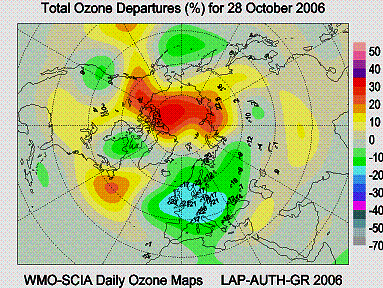October 2006
From the 25th October 2006, low ozone was measured over the UK and Western Europe. This was a persistent event lasting for about 5 days. Low ozone events were reported at Lerwick on the 27th and at Reading on the 29th and 30th October. Figure A below shows the ozone anomaly on the 28th, which was the day of the maximum area of ozone depletion for this event. At this time there was simultaneous anomalous high ozone over the Arctic. This pattern is known as a dynamical wave number one disturbance. Stratospheric temperatures are also unusually low in over the UK and high over Alaska. There was a high-pressure ridge and seasonally very high surface temperatures over the UK. In the stratosphere, low-ozone air was advected from the South.

Figure A: Ozone Anomaly on the 28th October, which was the Day of the Maximum Area of Ozone Depletion for this Event.
Comparison with the satellite OMI observations showed more extreme depletion reported by the ground stations. This is a consistent pattern of previous low ozone events.
From the 25th October 2006, low ozone was measured over the UK and Western Europe. This was a persistent event lasting for about 5 days. Low ozone events were reported at Lerwick on the 27th and at Reading on the 29th and 30th October. Figure A below shows the ozone anomaly on the 28th, which was the day of the maximum area of ozone depletion for this event. At this time there was simultaneous anomalous high ozone over the Arctic. This pattern is known as a dynamical wave number one disturbance. Stratospheric temperatures are also unusually low in over the UK and high over Alaska. There was a high-pressure ridge and seasonally very high surface temperatures over the UK. In the stratosphere, low-ozone air was advected from the South.

Figure A: Ozone Anomaly on the 28th October, which was the Day of the Maximum Area of Ozone Depletion for this Event.
Comparison with the satellite OMI observations showed more extreme depletion reported by the ground stations. This is a consistent pattern of previous low ozone events.
